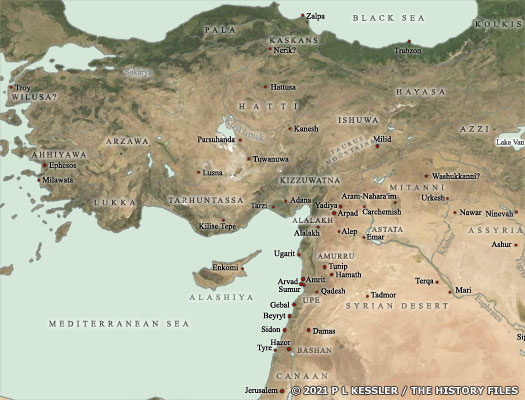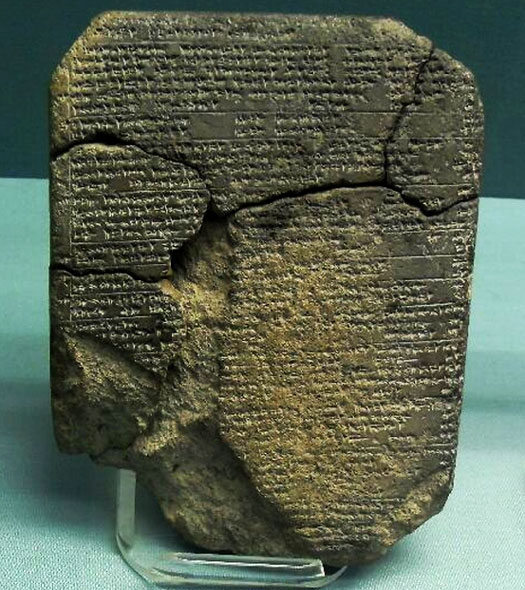
| UGARIT Although Ugarit was probably occupied much earlier, its first permanent settlement seems to date to around 6000 BC, at which point a fortified wall was put up around it. The city was located on the Syrian coast, and remains within modern Syria. It lay on the crossroads of trade routes from Babylonia, Anatolia and Egypt and, thanks to its good sea harbour, traders from all the major states conducted business there. First mentioned in records in about 1800 BC by Ebla, the city reached its height during the mid-fifteenth century BC under Egyptian overlordship, and maintained its position until the start of the twelfth century BC.
Ugarit has so far provided archaeologists with the largest selection of Syrian texts, including something unique to this city: two private libraries which both date from Ugarit's last days, although other cities, such as Emar, have yielded literary material as well. Ugarit's own script seems to have originated about 1400 BC, when cuneiform characters were adapted to the local language. Such works are the only extensive remnants of literature from this area, except for the later Hebrew Bible. Culturally Ugarit was heavily influenced by the Hurrian empire of Mitanni during the middle centuries of the second millennium. Syrian musicians at Ugarit performed Hurrian compositions.
(Information by Peter Kessler, with additional information from Mittani Empire and the Question of Absolute Chronology: Some Archaeological Considerations, Mirko Novák (published as part of The Synchronisation of Civilisations in the Eastern Mediterranean in the Second Millennium BC III, Manfred Bietak & Ernst Czerny (Eds), Österreichische Akademie der Wissenschaften Denkschrift Band XXXVII; Wien, 2007), from Historical Atlas of the Ancient World, 4,000,000 to 500 BC, John Haywood (Barnes & Noble, 2000), from The Ancient Near East, c.3000-330 BC, Amélie Kuhrt (Volumes I & II, Routledge, 2000), from The Penguin Atlas of Ancient History, Colon McEvedy (which misses the period 1600-1300 BC but shows a Mitanni kingdom in 1300-1000 BC, by which time it had certainly disappeared - Penguin Books, 1967, revised 2002), from The Hurrians, Gernot Wilhelm (Aris & Philips Warminster 1989), and from A History of the Ancient Near East c.3000-323 BC, Marc van der Mieroop (Blackwell Publishing, 2004, 2007).)
c.6000 BC :
Ugarit is first founded as a permanent settlement, probably after some centuries (or even millennia) of being used as a seasonal encampment. The erection of a fortified wall at this point shows that the settlement pattern here has changed, and that the site's current occupants have no plans to leave.
c.1776 BC :
Following the break-up of the kingdom of Upper Mesopotamia, Yamkhad becomes the dominant force in north-western Syria, controlling Ugarit.
Small cities and minor states that had been founded by the Hittites littered the meeting point between Anatolia and Syria (in the ancient period there was significant overlap between the two), with the coastal city of Ugarit being located directly to their south c.1478 BC :
Egypt expands rapidly through Palestine and reaches Mitanni-controlled Syria, making Ugarit a vassal state. The Egyptians also raid further inland, where local resistance is supported by Mitanni. Hittite agents are constantly at work, trying to draw Syrian states over to them, a policy which gradually sees them gain more influence. Nothing is known about the three earliest named rulers of Ugarit.
c.1430 BC :
The Hittite ruler, Tudhaliya II, begins a restoration of Hittite power, conducting his third campaign against the Kaskans in the north and concluding a treaty with Arzawa. Probably coincidentally, a series of kings rules Ugarit from this period onwards, although it is more likely that the Hittite resurgence also sparks a more general resurgence that encourages better records-keeping.
fl c.1420s? :
Niqmadu I / Nqmd : Name alone recorded.
Yaqurum : Name alone recorded.
Ibiranu I : Name alone recorded.
? - c.1354 BC :
Ammistamru I / Amttmr / Am-my-is-tam-ru
c. 1353 - 1318 BC :
Niqmadu II / Nqmd : Son. Became a vassal of the Hittites.
c.1340 BC :
Suppiluliuma, the new Hittite ruler, takes control of northern Syria by dealing Mitanni a final defeat. To all intents and proposes this also ends Hurrian culture which has previously provided a heavy influence upon Ugarit. The king of Ugarit informs the Hittites of a planned revolt by Alalakh, so that kingdom is incorporated directly into the empire and its lands are assigned to Ugarit as a reward, along with the territories of Nuhašše and Niya (in northern Syria). Ugarit remains a Hittite subject state but with its own royal house still in place.
c.1317 - 1314 BC :
Arhalba / Ar-Khalba : Son. Removed for revolting.
c.1313 - 1251 BC :
Niqmepa : Brother. Selected by Mursili II.
1286 BC :
The Battle of Kadesh/Qadesh (the earliest surviving report of a major engagement) sees the forces of Egypt, under Ramses II, and the Hittites together with their various allies, including troops from Arzawa and the Lukka, clash for control of former Mitanni Syria. The battle ends with no clear outcome although the Hittites come out on top, gaining uncontested control of Syria, and also raiding further south into Canaan. The victory, though, seems to spark the beginnings of a civil war in the Hittite nobility which lasts for about three generations.
The 'Aleppo Treaty' was drawn up on a cuneiform tablet between Mursili II of the Hittites and Talmi-Sharruma of Alep in the mid-fourteenth century, reflecting the increasing Hittite influence in the region at the expense of the Mitanni c.1250 - 1210 BC :
Ammistamru II : Son. Divorced his wife, daughter of Benteshina of Amurru.
c.1209 - 1200 BC :
Ibiranu II : Son.
c.1200 - 1195 BC :
The Hittite empire is destroyed by the Kaskans and the Sea Peoples. Other important Hittite cities such as Emar also disappear after a period of troubles which are characterised by attacks by seaborne raiders. There may be a severe attack on Ugarit around 1195 BC, as some sources date this as the city's last days.
c.1199 - 1192 BC :
Niqmadu III / Nqmd : Son. Vassal to Carchemish.
c.1191 - 1182 BC :
Ammurapi / Hammurabi : Possible usurper, emphasising the absence of Hittite control.
c.1182 BC :
Ammurapi is the last ruler of Ugarit. Much of Ugarit's army is in Hittite Anatolia (and probably lost by this time), and the fleet is near the Lukka lands, despite advice from the kings of Alashiya and Carchemish that Ugarit should look to its own defence. Consequently, the city is attacked by seven ships of Sea Peoples (believed to be the Shekelesh) and is destroyed. The state disappears from the historical record and its location is forgotten until 1928, although the former 'summer palace' at Ras Ibn Hani is soon reoccupied and rebuilt.
Source :
https://www.historyfiles.co.uk/ |

